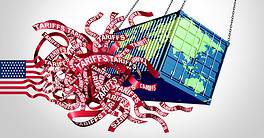Embedded finance is revolutionizing global trade, making financing as simple as a click, and empowering SMEs previously locked out of traditional systems.
Imagine a world where accessing trade finance is as simple as clicking a button, woven seamlessly into the fabric of online commerce. This isn’t a distant future; it’s the promise of embedded finance (EF), and it’s transforming global trade.
Traditional trade finance is often slow, complex, and difficult to access, leaving many small and midsize enterprises (SMEs) struggling to secure funding. EF offers a potential multibillion-dollar opportunity to streamline transactions and empower businesses. By integrating financial services into nonfinancial platforms, EF allows companies to access financing options like invoice factoring or supply chain finance at the point of transaction.
The shift in how goods and services are bought and paid for is driven by e-commerce growth and infrastructure governed by application programming interface (API) rules and protocols. APIs, blockchain, and artificial intelligence (AI) are the core technologies behind EF. APIs allow real-time data sharing and quick credit approvals, blockchain ensures transaction security, and AI automates risk assessment for faster funding. AI also increases access to financing for SMEs, whether via the integration of EF into e-commerce platforms or the provision of business-to-business (B2B) buy now, pay later services.

Already we are seeing the emergence of EF APIs like Plaid and Stripe Treasury. Plaid connects to bank accounts and Stripe connects to cards. Both enable real-time data sharing and instant credit decisions, crucial for embedded trade finance. Fintechs are joined by big banks like HSBC and Standard Chartered and online giants like Amazon, Alibaba, and PayPal in mining this new line of business.
Future Market Insights projects EF revenues growing to $291.3 billion by 2033, up from $63.2 billion in 2023. As EF continues to mature, it has the potential to level the playing field, empowering businesses of all sizes to participate in global trade and drive economic growth.
“Entrepreneurs build and innovate at warp speed, but traditional banks haven’t kept up,” Shopify argued when it unified all of its financial solutions under the Shopify Finance platform last October. In a Shopify-Gallup Entrepreneurship study of nearly 47,000 entrepreneurs, 60% rated lack of funding as the biggest challenge they face.
To help remedy cash shortfalls at startups, Shopify Balance provides an alternative to traditional business banking, providing merchants with next-day payouts, while Shopify Capital loans provide faster funding for eligible merchants, regardless of size and financial maturity.
Shopify is not EF’s only new kid on the block. In November 2023, FreshBooks, which provides cloud-based accounting software for small businesses, partnered with YouLend to launch a flexible financing solution for more than 100,000 customers across the US.
These platforms are well positioned for EF because they control the customer journey, accumulate rich data on transaction history, and can integrate financial services seamlessly.
The Big Banks Catch On
The EF shift in e-commerce is not happening in isolation; traditional financial institutions also recognize the opportunity, driving collaboration between banks and fintechs as they realize they can achieve more together.
Last October, HSBC launched a jointly owned venture, Semfi, in partnership with Tradeshift, a B2B global network, to deliver seamless EF solutions to businesses on e-commerce platforms. Semfi embeds HSBC’s payment and trade solutions across Tradeshift’s B2B network, enabling SME suppliers to access faster and more-transparent digital invoice financing from HSBC via e-commerce platforms.
Some banks are building their own banking-as-a-service (BaaS) platforms. Standard Chartered’s BaaS platform nexus, which allows e-commerce partners to offer their customers EF propositions, led to the launch of the Audax platform, which embeds the technology stack in other financial institutions.
BNY’s Trade Network Access Service (TNAS) aims to simplify trade finance for other banks. Instead of managing complex systems for international transactions all by themselves, banks can connect to a global network via TNAS, reducing costs and expanding their reach. This plug-and-play approach makes it easier for smaller banks to offer sophisticated trade finance services, ultimately benefiting their customers.
“By utilizing value-added risk mitigation and financing services,” says Joon Kim, global head of Trade Finance, Working Capital, and Portfolio Management at BNY Treasury Services, “adopters of TNAS can enhance trade revenue by having access to over 4,000 [relationship-management applications] across the globe. TNAS offers distinctive value in a buy-versus-build solution in an area where a financial institution’s need may not be consistent day-to-day.”
While not a new concept in trade finance, EF’s impact could be felt all along the transactional chain, from large to small financial institutions to their customers, Kim argues.
“From a growth perspective,” he says, “if you consider the limitations of a smaller regional or community bank trying to reach networks that provide international access for an importer or exporter, such access could lead to direct growth from providing everything spanning foundational access to more end-to-end needs.” Efficiency and client service improve when trade finance is a one-stop shop with frictionless delivery of services ranging from letters of credit to trade distribution.
“Innovation via digitalization and collaboration has been moving the industry forward and will only continue as more parties make the move away from manual processes,” Kim predicts.
Where Tech Meets Trade
Singapore-based fintech Xalts, which trains AI agents in multiple trade finance tasks including documentary credit, guarantees, and collections, bought the digital trade platform Contour Network early last year to streamline digital connectivity between banks and corporates. Xalts first examines every problem with an agent, then delves deep to introduce a fully vertical solution for finance teams.
“Due to our integrations with leading banks globally and our expertise in trade finance, we are the only company which is building vertical AI agents to solve operational challenges in trade finance,” says Xalts CEO Ashutosh Goel.
“The biggest barrier to trade finance digitalization, and hence offering embedded trade finance solutions, has been the manual nature of trade finance processes,” he adds. “With our AI agents and now the added capabilities [from Contour] of sending trade transactions to banks, we are solving the operational challenges that come with embedding trade finance solutions.”
The Xalts platform integrates with enterprise resource planning software, accounting systems, logistics partners, and banks, while its AI agents use large-language models to reduce integration times and costs for any platform. The agents consume data in a format-agnostic manner and process outcomes as per the organization’s preexisting policies.
“This allows organizations to introduce new solutions,” continues Goel, “including embedded trade finance, seamlessly as operational processing is simplified, because agents can deal with end-to-end flow in any transaction: including sending transactions to banks.”
Online marketplaces have led when it comes to EF as they seek to integrate financial services into their ecosystems. Increasing customer satisfaction and loyalty also creates monetization opportunities.
Amazon and Alibaba each offer trade finance, for example. Amazon makes working capital loans to Amazon sellers via its Amazon Lending program and other loan options, including daily advances, merchant cash advances, and invoice finance.
Alibaba has partnered with lenders, credit-rating agencies, and banks to provide trade finance. It also extends payment terms up to 60 days for SMEs. Similarly, PayPal Working Capital offers cash advances of $1,000 to $200,000 to first-time applicants—and up to $300,000 to subsequent applicants—based on their PayPal sales volume and account history.
Further digitalization and standardized trade documentation, coupled with SWIFT-powered interoperability studies, promise to unlock EF’s potential even further as more offerings emerge.




